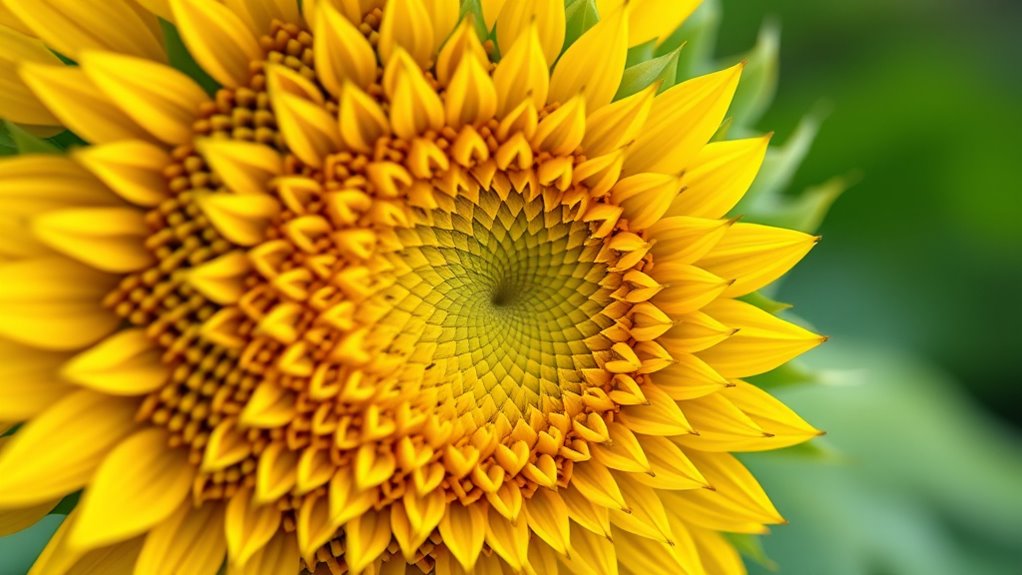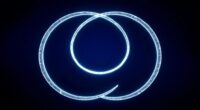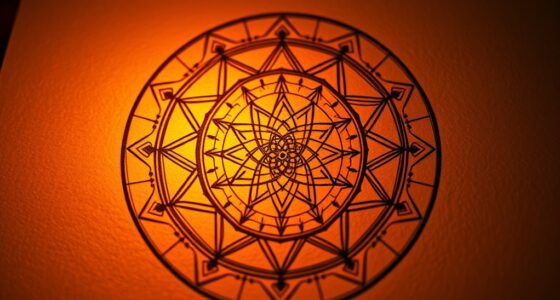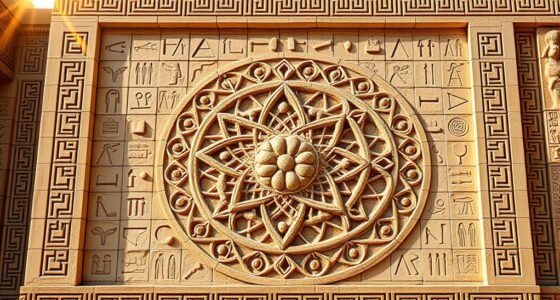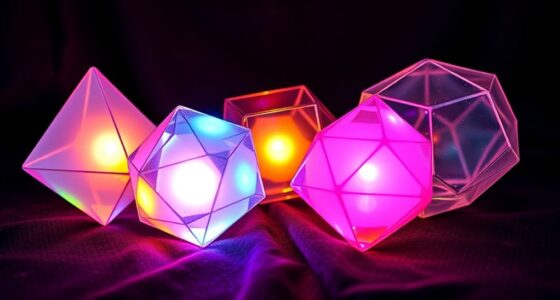You’ll find the Fibonacci sequence everywhere in nature and sacred geometry, from spirals in galaxies and shells to the arrangement of leaves and sunflower seeds. This pattern influences natural growth, creating efficiency and beauty. It also underpins the golden ratio, which guides art and architecture for harmony and balance. Exploring how this sequence shapes our world can reveal fascinating connections that extend beyond what you see every day. Continue to discover more about this remarkable pattern.
Key Takeaways
- Fibonacci sequence appears in natural forms like plant arrangements, shells, and galaxies, demonstrating its role in natural growth and efficiency.
- It is closely related to the golden ratio, which underpins aesthetic harmony in art, architecture, and sacred geometry.
- Fibonacci spirals are used in art and architecture to create balanced, visually pleasing designs.
- The sequence reveals universal patterns of order, growth, and space optimization in both nature and human creations.
- Sacred geometry incorporates Fibonacci principles to symbolize spiritual harmony and aesthetic balance.
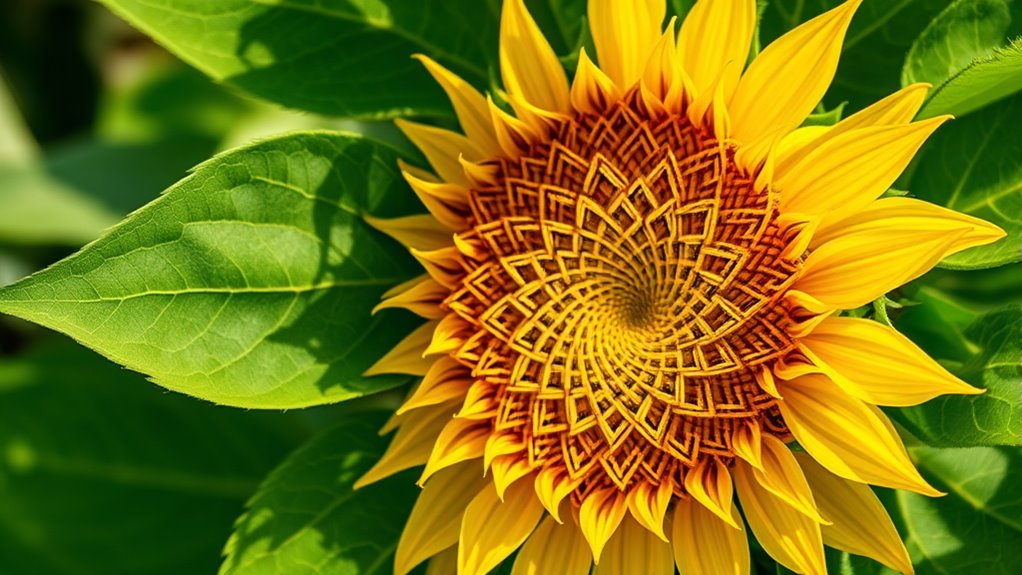
The Fibonacci sequence is a fascinating mathematical pattern that appears repeatedly in nature and sacred geometry. You might notice that this sequence, starting with 0 and 1, then adding the two previous numbers to get the next (1, 1, 2, 3, 5, 8, 13, and so on), manifests in countless natural forms. From the arrangement of leaves on a stem to the spirals of shells and galaxies, these mathematical patterns reveal a fundamental order in the universe. As you observe these structures, it becomes clear that the Fibonacci sequence isn’t just an abstract concept; it’s embedded deeply in the fabric of life itself. This sequence helps describe growth patterns, optimize space, and create harmonious proportions. The Fibonacci sequence is also closely related to the golden ratio, which is often associated with aesthetic beauty and balance. In sacred geometry, the Fibonacci sequence holds a special significance because it underpins the aesthetic principles seen in art, architecture, and spiritual symbolism. Artists and architects have long used these mathematical patterns to create visually appealing and balanced designs. The Fibonacci spiral, for example, is often incorporated into visual art and design to produce a sense of natural harmony and flow. When you see a sunflower or a pinecone, notice how the arrangement of seeds or scales aligns with Fibonacci ratios, providing both efficiency and beauty. This natural occurrence of mathematical patterns guides artists in crafting works that resonate on a subconscious level, tapping into universal principles of proportion and balance.
The artistic applications of the Fibonacci sequence extend beyond natural mimicry. Artists and designers use Fibonacci-based proportions, such as the golden ratio derived from the sequence, to develop compositions that feel naturally pleasing. You may recognize this in famous artworks, where the placement of focal points aligns with Fibonacci spirals or ratios. Architects also incorporate these principles into building facades and interior layouts to evoke harmony and aesthetic appeal. These patterns help create a sense of order that’s both intellectually satisfying and visually compelling, demonstrating how mathematics and art intertwine seamlessly.
Frequently Asked Questions
How Does Fibonacci Sequence Influence Modern Architectural Design?
You see the Fibonacci sequence influence modern architectural design through its use in creating harmonious proportions and enhancing structural stability. Architects often incorporate Fibonacci ratios to craft visually pleasing spaces that feel natural and balanced. These proportions help distribute weight effectively, improving the building’s strength. By applying Fibonacci principles, you guarantee your designs are both aesthetically appealing and structurally sound, making your projects stand out with timeless elegance and functional stability.
Are There Any Cultural Myths Associated With Fibonacci Patterns?
You might see Fibonacci patterns as a myth woven into cultural symbolism, like a secret code from ancient times. These patterns often symbolize harmony, growth, and divine proportion, fueling myths about mystical powers and universal truths. Their cultural significance spans civilizations, from Egyptian to Greek, inspiring stories that link mathematical beauty with spiritual wisdom. The Fibonacci sequence becomes a mythical symbol, bridging science and sacred storytelling in human history.
Can Fibonacci Numbers Be Found in Microscopic Biological Structures?
Yes, you can find Fibonacci numbers in microscopic biological structures. These patterns appear in biological patterns like the arrangement of cells, scales, and even some microscopic structures within organisms. You might notice Fibonacci sequences in the spiral arrangements of tiny shells or microscopic plant parts, revealing how nature uses these mathematical patterns at a very small scale. This illustrates how Fibonacci numbers influence biological structures, even at microscopic levels.
What Is the Mathematical Relationship Between Fibonacci and Other Sacred Geometries?
You see that the Fibonacci sequence relates to sacred geometries through mathematical ratios like the golden ratio, approximately 1.618. These ratios appear in geometric patterns such as the pentagon, pentagram, and spirals, creating harmony and balance. The sequence’s ratios often underpin complex designs in architecture, art, and nature, revealing a deep connection between mathematical ratios and sacred geometries, emphasizing universal principles of beauty and structure.
How Does Fibonacci Sequence Relate to Plant Growth Beyond Spiral Patterns?
Did you know that about 75% of flowering plants show Fibonacci-related patterns beyond spirals? You see, the Fibonacci sequence influences plant growth through efficient plant cell division and nutrient distribution. This means plants optimize space and resource flow, ensuring healthy development. By following Fibonacci numbers, plants can maximize exposure to sunlight and better distribute nutrients, making their growth more effective and resilient—showing Fibonacci’s essential role beyond just spiral patterns.
Conclusion
You might notice how the Fibonacci sequence appears everywhere—like a secret code woven into nature’s design. Coincidentally, this timeless pattern also underpins sacred geometry, connecting the universe’s most profound mysteries. When you see these spirals in shells or galaxies, it’s like discovering a hidden harmony that guides everything. It’s almost as if nature and the cosmos are whispering the same language, reminding you of the incredible interconnectedness that surrounds us all.

